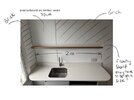Apologise for my first, very basic post, we're looking to put up a shelf in the kitchen for basic usage (not too heavy items, more decrotive). At first it was floating, but now we may use brackets as Im concerned about the weight (we could have 3 brackets). We would love oak wood but this'll probably be too much weight. What alternative could you use if the wall is like Pasterboard with on timber joists. It'll be around 180cm wide perhaps. Anyone know of a good link in the UK to get something ordered.
lister
lister
Attachments
Last edited:


